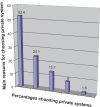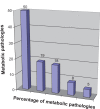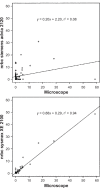Public banking of umbilical cord blood or storage in a private bank: testing social and ethical policy in northeastern Italy
- PMID: 23610532
- PMCID: PMC3628527
- DOI: 10.2147/JBM.S41532
Public banking of umbilical cord blood or storage in a private bank: testing social and ethical policy in northeastern Italy
Abstract
Background: In northeastern Italy, according to Italian legislation, authorized public facilities can accept the donation and preservation of cord blood stem cells (CB-SC). Attitudes and knowledge in pregnant women differs between the local and immigrant (non-European Union [EU]) population. In this study we assessed the choices that pregnant women have with respect to the public and private harvesting system and the main reasons driving their decisions. We examined the ethnic origin of the families and compared tests for syphilis screening and leukocyte (WBC) counts in the CB-SC bags that are required for validation of the collection.
Methods: Out of a population of 3450 pregnant patients at the Institute for Maternal and Child Health of Trieste, northeast Italy, 772 women agreed to cord blood harvesting and the associated lab tests. Of these, 221 women (28.6%) were from immigrant families of non-EU countries. Their ethnic affiliation was recorded, and tests were performed for syphilis screening and for nucleated red blood cell (NRBC) interference with the WBC count in CB-SC bags to assess cellularity and to determine if storage was appropriate.
Results: Of the 772 pregnant women, 648 (84.0%) accessed the public collection system, which is free of charge, and 124 (15.0%) accessed the private fee-based system. One woman from the non-EU group opted for the private fee-based system. Of the 3450 pregnant women screened for syphilis at the Institute for Maternal and Child Health, the Treponema pallidum hemagglutination (TPHA) and Venereal Disease Research Laboratory (VDRL) tests were the main tests performed (66.0% of total cases) because many gynecologists in the public harvesting system apply the Italian regulations of the 1988 Decree, while the private system requires tests on syphilis and leaves the option to the lab physicians to select the best determination method. We found that the chemiluminescence method was more specific (97.0%) than the TPHA (83.0%) and nontreponemal rapid plasma reagin VDRL (75.0%) tests (P < 0.05, χ(2) test). The specificity link between the two automatic methods versus microscopes for WBC dosing and NRBC interference was r(2) = 0.08 (ADVIA 120) and r(2) = 0.94 (XE-2100). The public system does not include human T-cell lymphotropic virus testing; this is reserved for the population from endemic zones.
Conclusion: In northeastern Italy current legislation prevents the establishment of private fee-based banks for storage of CB-SC. The cryopreservation, for future autologous personal or family use, is possible only by sending to foreign private banks, with a further fee of €300. These regulations confirm that Italian legislation tries to increase the anonymous allogenic donations and the number of CB-CS bags stored in the free-cost public system, that are available to anyone with therapeutic needs. Private banking is used almost exclusively by the wealthier local population. In the public system, many physicians continue to use older Italian laws regarding syphilis diagnosis, and NRBC interference on WBC count may have an impact on cord blood harvesting. Our findings suggest that in the EU there is no consensus policy on donor management. The value of storage for potential use within the family is useful only with collaboration between the public and the private systems.
Keywords: cord blood collection; pregnant women’s choice; private system; public system.
Figures



Similar articles
-
Autologous cord blood harvesting in North Eastern Italy: ethical questions and emerging hopes for curing diabetes and celiac disease.Int J Gen Med. 2012;5:511-6. doi: 10.2147/IJGM.S31977. Epub 2012 Jun 15. Int J Gen Med. 2012. PMID: 22807638 Free PMC article.
-
Hybrid cord blood banking in a private-public-partnership: Women's perspectives.Transfusion. 2024 Jul;64(7):1270-1278. doi: 10.1111/trf.17858. Epub 2024 May 15. Transfusion. 2024. PMID: 38746954
-
Cord blood stem cell banking: a snapshot of the Italian situation.Transfusion. 2011 Sep;51(9):1985-94. doi: 10.1111/j.1537-2995.2011.03089.x. Epub 2011 Mar 18. Transfusion. 2011. PMID: 21418078
-
Cord Blood Banking Standards: Autologous Versus Altruistic.Front Med (Lausanne). 2016 Jan 8;2:94. doi: 10.3389/fmed.2015.00094. eCollection 2015. Front Med (Lausanne). 2016. PMID: 26779485 Free PMC article. Review.
-
Umbilical cord blood donation: public or private?Bone Marrow Transplant. 2015 Oct;50(10):1271-8. doi: 10.1038/bmt.2015.124. Epub 2015 Jun 1. Bone Marrow Transplant. 2015. PMID: 26030051 Review.
Cited by
-
Recent updates of stem cell-based erythropoiesis.Hum Cell. 2023 May;36(3):894-907. doi: 10.1007/s13577-023-00872-z. Epub 2023 Feb 9. Hum Cell. 2023. PMID: 36754940 Free PMC article. Review.
-
Industrially Compatible Transfusable iPSC-Derived RBCs: Progress, Challenges and Prospective Solutions.Int J Mol Sci. 2021 Sep 10;22(18):9808. doi: 10.3390/ijms22189808. Int J Mol Sci. 2021. PMID: 34575977 Free PMC article. Review.
-
Parents' knowledge, awareness and attitudes of cord blood donation and banking options: an integrative review.BMC Pregnancy Childbirth. 2018 Oct 10;18(1):395. doi: 10.1186/s12884-018-2024-6. BMC Pregnancy Childbirth. 2018. PMID: 30305052 Free PMC article. Review.
-
Comparison of syphilis seropositivity between non-immigrant and immigrant populations in the Anatolian side of Istanbul, Turkiye: Results of five-years retrospective study.North Clin Istanb. 2022 Dec 22;9(6):590-594. doi: 10.14744/nci.2021.80688. eCollection 2022. North Clin Istanb. 2022. PMID: 36685633 Free PMC article.
-
Syphilis Laboratory Guidelines: Performance Characteristics of Nontreponemal Antibody Tests.Clin Infect Dis. 2020 Jun 24;71(Suppl 1):S21-S42. doi: 10.1093/cid/ciaa306. Clin Infect Dis. 2020. PMID: 32578862 Free PMC article. Review.
References
-
- Gluckman E, Broxmeyer HE, Arlen D, et al. Hematopoietic reconstitution in a patient with Fanconi’s anemia by means of umbilical cord blood from an HLA identical sibling. N Engl J Med. 1989;321:1174–1178. - PubMed
-
- European Directorate for the Quality of Medicines and Health Care of the Council of Europe (EDOM) Guide to the preparation, use and quality assurance of blood components. Recommendation No R(95) 15 Available at http://www.eubis-europe.eu/documents.phpAccessed March 9, 2012
-
- Ballen KK. Challenges in umbilical cord blood stem cell banking for stem cell reviews and reports. Stem Cell Rev. 2010;6:8–14. - PubMed
-
- Lubin BH, Shearer WT. Cord bank banking for potential future transplantation. Pediatrics. 2007;119(1):165–170. - PubMed
LinkOut - more resources
Full Text Sources
Other Literature Sources
Miscellaneous

